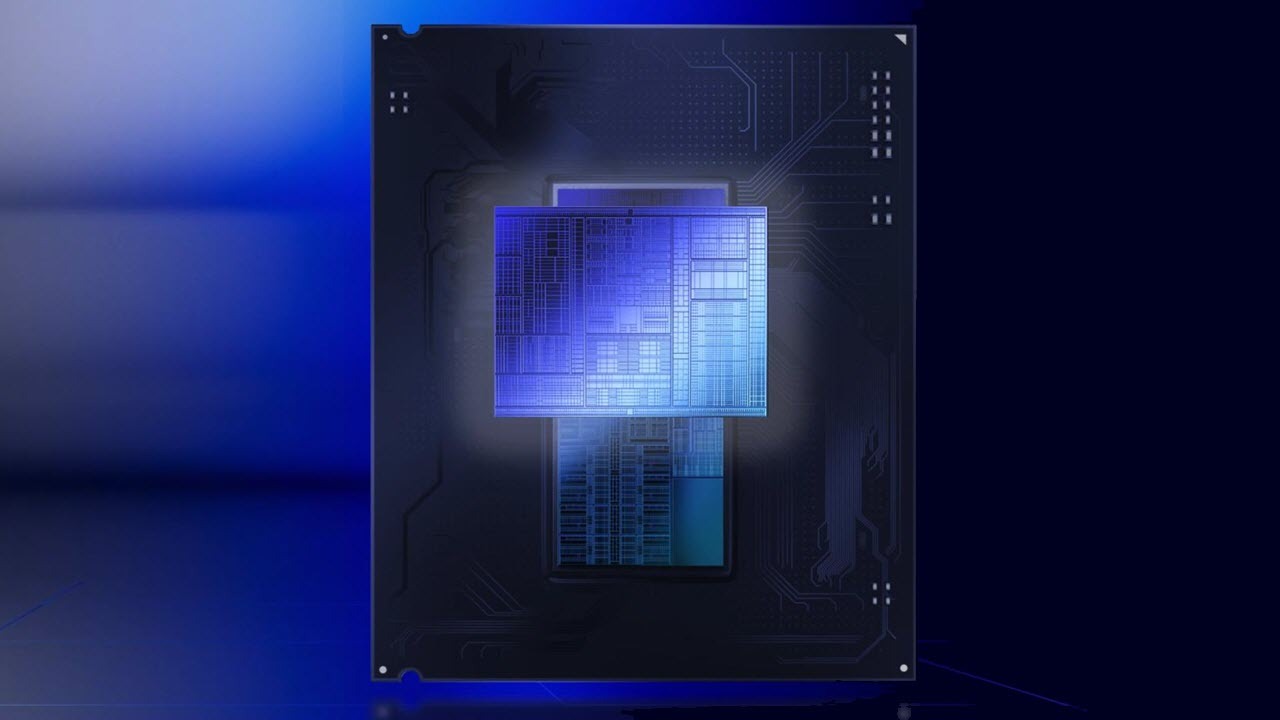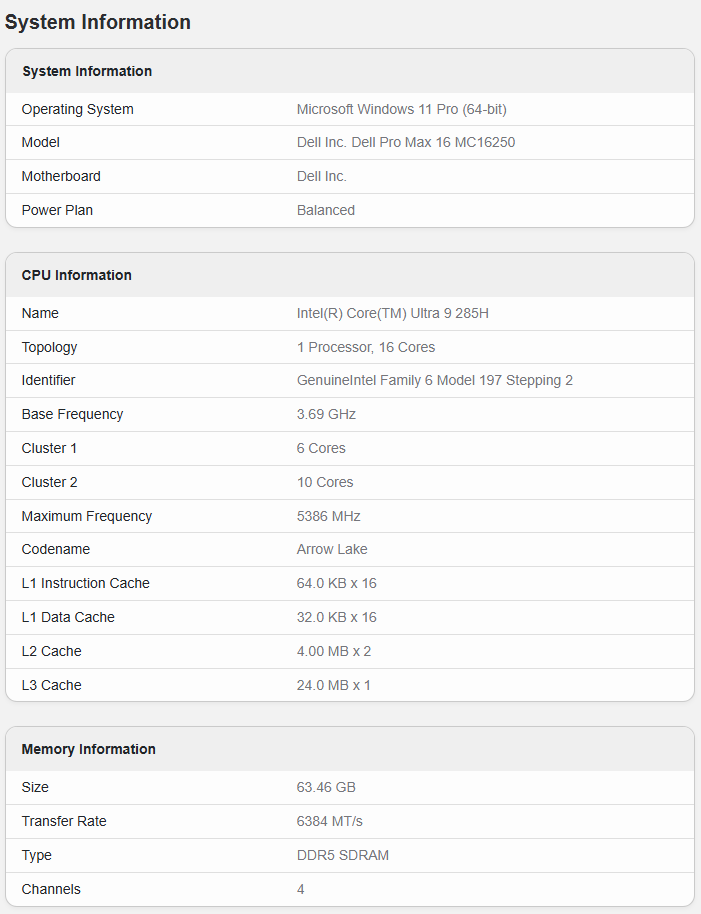Intel Core Ultra 9 285H 45W mobile CPU falls short of its Lunar Lake brethren in leaked Geekbench 6 single-core benchmark
Still around 19% faster than the Core Ultra 9 185H.

A new benchmark has surfaced on Geekbench showcasing Intel's upcoming mobile Core Ultra 9 285H in action. Initial scores put it a smidgeon behind Lunar Lake in terms of single-core performance. Against Meteor Lake, the CPU manages to pull ahead by 19% at roughly the same power envelope, giving us cause for some optimism.
Intel's new Core naming schematic has some weird nuances. To keep things short, any CPU without the "Ultra" moniker is equipped with Raptor Lake / Alder Lake silicon. Hence, the Core Ultra 9 285H is part of the Arrow Lake-H family and should feature a TDP of 45W.
Spotted in the upcoming Dell Pro Max 16 (MC16250) laptop, the Core Ultra 9 285H offers 16 cores (six P + eight E + two LPE) and 16 threads. The laptop hosts 64GB of DDR5-6400 memory - one of the highest speeds we've seen for SODIMMs, assuming the laptop doesn't use LPDDR5 memory. The CPU achieved a maximum clock speed of 5.4 GHz, just 100 MHz shy of the desktop Core Ultra 7 265K.

The Core Ultra 9 285H managed to score 2,665 and 15,330 points in the single-core and multi-core categories, respectively. Don't get us wrong - the performance is acceptable at roughly 19% faster than the Core Ultra 9 185H from the last generation but fails to match Lunar Lake's Core Ultra 9 288V (30W). The worst part is that the Core Ultra 9 288V scores higher at just 5.1 GHz, meanwhile, the 285H pushes upwards of 5.4 GHz so something is clearly wrong with this benchmark.
Since we are unaware of the operating environment and temperature, it is not possible to draw any judgments yet. Case in point - the leaked 65W Core Ultra 9 285 non-K scored 3,247 points (single core) landing it 21% faster than the 285H. Hence, this is likely an engineering sample or a result of poor testing conditions.

Nonetheless, we expect this CPU to come paired with an RTX 40, maybe even an RTX 50 laptop GPU in gaming notebooks next year. Despite the initial disappointment, Arrow Lake scales pretty well at lower power limits so there is a lot of room for improvement. Intel is rumored to announce its Core Ultra 200H/HX/S non-K CPUs at CES 2025, or in just two months.
Get Tom's Hardware's best news and in-depth reviews, straight to your inbox.

Hassam Nasir is a die-hard hardware enthusiast with years of experience as a tech editor and writer, focusing on detailed CPU comparisons and general hardware news. When he’s not working, you’ll find him bending tubes for his ever-evolving custom water-loop gaming rig or benchmarking the latest CPUs and GPUs just for fun.
-
rluker5 Another core configuration?Reply
I wonder if the memory controller is on the same die as the cores with this one?
We don't even know what node it is because Intel can just switch nodes and fab companies with their designs now.
Playing with these configurations like they are Legos. -
User of Computers what? That's the Ultra 5 245K's config except they're using the MTL SoC tile and either the MTL-H or -U GPU tileReply
rluker5 said:Another core configuration?
I wonder if the memory controller is on the same die as the cores with this one?
We don't even know what node it is because Intel can just switch nodes and fab companies with their designs now.
Playing with these configurations like they are Legos. -
rluker5 Reply
So their high end is using a cut down die? Not likely.User of Computers said:what? That's the Ultra 5 245K's config except they're using the MTL SoC tile and either the MTL-H or -U GPU tile -
Aart de Vries My GeekBench 6 score for my 258V 17W Lunar Lake are 2806 / 11355 (higher than the referenced 288V 30W processor), meaning that my 17W LL outperforms this 45W H-series processor by more than 5% single core. Admittedly my MultiCore score falls short 25%, but that is with half the number of cores available (4P + 4E vs 6/10). I think having the 32GB memory inside the CPU package is genius (I'm not an Apple fan, but they got it right too). And Pat is saying that CPU packaged RAM of LL is a one-off. I think from both a performance and energy efficiency standpoint it is genius. I bought a LL based laptop over a Strix Point one exactly for these reasons. So if Intel wants to keep there market share up, they should really have a good look at what works or not.Reply -
User of Computers Reply
what do you mean by cut down? They're reusing old parts because there's no reason to make new ones (which costs them money which they don't have)rluker5 said:So their high end is using a cut down die? Not likely. -
DS426 Dell jumped on the "Pro Max" bandwagon as well?? Come on folks, stop rubbing Apple's ego.Reply
Big tech marketing: we only need one suffix adjective. There's plenty out there and smashing similar ones together is just silly. For example in this case, "Max" is greater than "Pro," so the latter is superfluous.
Yes, sort of ranting so back on topic: Pat @ Intel did say that Lunar Lake was a one-off; I have to think that stripping back the on-package LPDDR is measurably going to hurt performance, even if power efficiency is possibly the larger advantage of that feature... depends on workload too I suppose. -
thestryker Reply
I think the point is that the ARL desktop parts all use the same die and in the past the mobile parts have had a separate die rather than a cut down desktop one (except the HX which are literally the desktop chips silicon wise). All of MTL mobile used the same die, and if they were to do the same for ARL mobile using the desktop compute tile would mean wasted silicon because the highest laptop configuration should be 6+8 and if there's an HX it should be using the same die as desktop.User of Computers said:what do you mean by cut down? -
Mama Changa Wow another garbage Dell with poor thermal performance and severe throttling. People have been slamming Dell for years over this sort of crap. Also, I would never ever buy a 24 core laptop apu unless it had a true work station chassis.Reply -
Pierce2623 Reply
This score is just bogus. The on package memory only improves efficiency and gives a negligible improvement to latency.Aart de Vries said:My GeekBench 6 score for my 258V 17W Lunar Lake are 2806 / 11355 (higher than the referenced 288V 30W processor), meaning that my 17W LL outperforms this 45W H-series processor by more than 5% single core. Admittedly my MultiCore score falls short 25%, but that is with half the number of cores available (4P + 4E vs 6/10). I think having the 32GB memory inside the CPU package is genius (I'm not an Apple fan, but they got it right too). And Pat is saying that CPU packaged RAM of LL is a one-off. I think from both a performance and energy efficiency standpoint it is genius. I bought a LL based laptop over a Strix Point one exactly for these reasons. So if Intel wants to keep there market share up, they should really have a good look at what works or not.